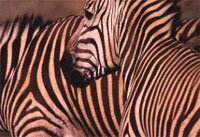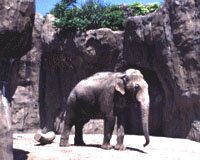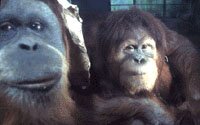Our Exhibits
| Africa Rain Forest | African Savanna | Cascades Stream and Pond |
| Bears | Elephant Museum | Felines |
| Elephants | Primates | Cascade Crest |
| Penguinarium | Alaska Tundra | Future Exhibits |
| Tree Kangaroos |
Africa Rain Forest
 Completed in 1991, and a variety of tropical birds and waterfowl live in a tangle of lush vegetation. In the Bamba du Jon Swamp building, visitors experience tropical thunder, lightning and a torrential downpour that passes over endangered slender-snouted crocodiles, monitor lizards, lung fish and frogs. In the Kongo Ranger Station, kids and adults get a hands-on educational experience and learn about the people of the rain forest, as well as the threats that animals face.
Completed in 1991, and a variety of tropical birds and waterfowl live in a tangle of lush vegetation. In the Bamba du Jon Swamp building, visitors experience tropical thunder, lightning and a torrential downpour that passes over endangered slender-snouted crocodiles, monitor lizards, lung fish and frogs. In the Kongo Ranger Station, kids and adults get a hands-on educational experience and learn about the people of the rain forest, as well as the threats that animals face.
| Mammals | Birds | Reptiles & Amphibians |
| Rodrigues Fruit Bats | Rock Python | |
| Big Fruit Bats | Hadada Ibis | Slender-snouted crocodiles |
| Egyptian Fruit Bats | Monitor Lizards | |
| Straw Colored Bats | Golden Mantella Frogs | |
| Colobus Monkeys | Fish | |
| Cape Clawless Otters | African Lung Fish | |
| Banded Mongooses | Ciclids |
Bold-face indicates endangered species
Africa Savanna
 The four-acre Africa exhibit, completed in replicates the dry, open bush country of East Africa. An indoor aviary houses colorful African birds and tropical vegetation. The exhibit's landscaping also includes a simulated riverbank.
The four-acre Africa exhibit, completed in replicates the dry, open bush country of East Africa. An indoor aviary houses colorful African birds and tropical vegetation. The exhibit's landscaping also includes a simulated riverbank.
| Mammals | Birds | Reptiles |
| Black Rhinoceroses | Weaver Birds | Mole Snakes |
| Hippopotamuses | Marabou Storks | Hingebacked Tortoise |
| Hartmann's Mountain Zebras | Cape Thick-Knee | |
| Naked Mole Rats | Red-crested Turaco | |
| Reticulated Giraffes | Hammerkop | |
| Impalas | Buffalo Weaver | |
| Debrazza's Monkeys |
Bold-face indicates endangered species
Alaska Tundra
 This exhibit immerses the visitor in the harsh, remote environment of Alaska's north slope. Animals of the region, such as musk ox, displayed in a setting that simulates the Arctic ecosystem. Visitors learn about this region through the aid of hands-on interpretive graphics, electronic learning games and a slide show.
This exhibit immerses the visitor in the harsh, remote environment of Alaska's north slope. Animals of the region, such as musk ox, displayed in a setting that simulates the Arctic ecosystem. Visitors learn about this region through the aid of hands-on interpretive graphics, electronic learning games and a slide show.
| Mammals | Birds |
| Musk Oxen | Snowy Owls |
| Grey Wolves | Short-eared owls |
| Grizzly Bears | |
| Brown Lemmings |
Bears
 Watch polar bears swim underwater in a simulated arctic exhibit. Then travel to tropics on the other side of the Pacific Ocean to see a smaller bear that likes to spend time in the trees.
Watch polar bears swim underwater in a simulated arctic exhibit. Then travel to tropics on the other side of the Pacific Ocean to see a smaller bear that likes to spend time in the trees.
| Mammals |
| Polar Bears |
| Malayan Sun Bears |
Bold-face indicates endangered species
Cascade Exhibit
 Recognized by the AZA as the best new zoo exhibit in 1983, this area showcases plant and animal life native to the west side of Oregon's Cascade Range. A quarter-mile-long trail planted with native vegetation meanders through the exhibit.
Recognized by the AZA as the best new zoo exhibit in 1983, this area showcases plant and animal life native to the west side of Oregon's Cascade Range. A quarter-mile-long trail planted with native vegetation meanders through the exhibit.
| Mammals | Birds | Reptiles, amphibians, etc. |
| Beavers | Great Horned Owls | Garter Snake |
| North American Otters | Golden Eagles | Tailed Frogs |
| Elk | Cutthroat Trout |
Felines
The feline building houses our very special tiger, Czar. This area of the zoo is being renovated.
Bold-face indicates endangered species
Elephants
 This zoo is recognized internationally for having the most successful breeding herd of Asian elephants of any zoo. In 1962, Packy became the first elephant born in the western hemisphere in more than 40 years. Since that time, twenty-seven calves have been born. Three males and six females, including three year old Rose-Tu, live here currently.
This zoo is recognized internationally for having the most successful breeding herd of Asian elephants of any zoo. In 1962, Packy became the first elephant born in the western hemisphere in more than 40 years. Since that time, twenty-seven calves have been born. Three males and six females, including three year old Rose-Tu, live here currently.
Penguinarium
 This exhibit is home to a colony of more than 35 Humboldt penguins--the most endangered of the penguin species--and a flock of Inca terns. Designed to replicate the rocky, warm coastline of their native habitat in Peru, the exhibit includes a wave machine and Jacuzzi-type jets that simulate the ocean currents. The penguinarium, completed in 1984, received a Significant Achievement Award from the American Zoo and Aquarium Association (AZA).
This exhibit is home to a colony of more than 35 Humboldt penguins--the most endangered of the penguin species--and a flock of Inca terns. Designed to replicate the rocky, warm coastline of their native habitat in Peru, the exhibit includes a wave machine and Jacuzzi-type jets that simulate the ocean currents. The penguinarium, completed in 1984, received a Significant Achievement Award from the American Zoo and Aquarium Association (AZA).
| Birds |
| Humboldt Penguins |
| Inca Terns |
Bold-face indicates endangered species
Primates
 Though it is one of our oldest exhibits, this area is a favorite of visitors because of the antics of it's residents. Because of the zoo's participation in national Species Survival Plans and international breeding programs for these endangered animals, many babies are born here.. A long-term study on chimpanzee development has been conducted since 1981.
Though it is one of our oldest exhibits, this area is a favorite of visitors because of the antics of it's residents. Because of the zoo's participation in national Species Survival Plans and international breeding programs for these endangered animals, many babies are born here.. A long-term study on chimpanzee development has been conducted since 1981.
Bold-face indicates endangered species
Cascade Crest
The exhibit, a replica of an alpine area in the Cascade Mountains,
features mountain goats and a simulated snow cave. Cascade Crest
is actually the first phase of a much larger exhibit, The Great Northwest.
